The owner of this interesting firearm (who is a regular reader of the site) sent me this information about it:

Here are the things I do know about this weapon, which is one if six in my collection. I am satisfied that it is was; a Springfield Model 1873 45-70, and I know it is not and never was a 1881 Forager. However, I am delighted to own such a fine specimen of the 45-70. I have no factual documented information on it. I recently saw a similar trapdoor for sale which was chambered in 28 ga, but was a parts gun, having ejection stud hole still visible, receiver machined, chamber and barrel reamed. I have had several people say “lots of these were done just by reaming out the old barrel, really nothing worth much, rather common”. To me that’s just so much hooey. I have only seen two in 40 years of collecting, (both 20ga). I have found no official write ups or gun magazines articles on 45-70 caliber chambered and barreled as shotgun weapons, though I am sure there must be some. This is what makes collecting worth while, the search.
I certainly would appreciate answers to any of these six basic interrogatives:
Who, What, When, Where, Why and How
For me the most important thing about it is; it is in my gun safe no matter what it is.
Known:
Side lock plate is 1873 (IAW, Poyar and Frasca, both recognized published Springfield experts.) All commercial rebuilds have a date under the word “Springfield” on left side where as no Springfield 45-70’s had a date in this location. (also this weapon has U.S. and date on breach block and no eagle, 6th model breach block).
Serial number coincides with 1873 existing Springfield historical records. And as stated by Poyer, the date 1873’s can be mistaken for 1878 as the 3 was often struck incorrectly, but can be seen with a magnifying glass. (this is a 6th model breach .. flat no arch)
Chamber is exact 45-70 specification – length, (base to throat) diameter at head and mouth.
Bore length 2.16 and diameter at throat .451, however at muzzle .560 diameter. Outside muzzle is .851 not normal .730. Barrel wall at muzzle is .275 thick (is a shortened barrel).
Barrel is a Springfield proofed barrel (underside of barrel)
Barrel has been tapped for rear sight then plugged. Position and distance of holes from receiver face are correct. (2.4 inch from breach)
Serial number precludes this from being or having ever been a Springfield Model 1881 Forager in 20 gauge
Foragers had their own serial number series (this weapon has normal range serial number)
Forager had “purpose” forged receivers without a ejection stud in bottom of receiver (this weapon has the normal stud)
Foragers did not have a barrel band (this weapon does)
This barrel shows no evidence of ever having lands or groves but is highly finished (purpose built not usual for a “smith quick reaming” job)
Front brass bead sight was standard as used during this 1800 period on shotguns
Winchester did load and produce shot shells (#4 and #6) in 45-70 as I have seen them and I have a wood sabot ed 45-70 containing two 00 buck. These were commercial rounds purchased by US Government.
The stock is a cut down rifle stock, as the cleaning rod hole patch clearly shows. The National Armory never cut down rifle stocks, this has to be a commercial.(this is as fine a repair as possible, beyond anything Bannerman took time to do)
The stock is stamp marked several places, comb near butt plate and on sides near butt. One appears to be B 5.
No issued “Foragers” had a Saddle Ring and Bar (SR) this has a genuine original bar and ring and the stock is perfectly inletted.
Additional photos:

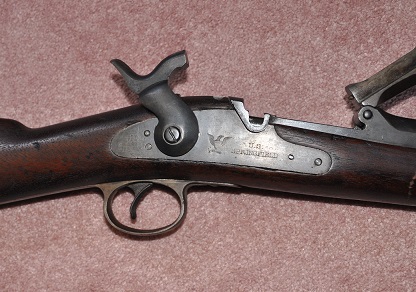
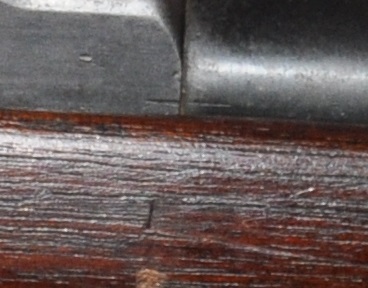
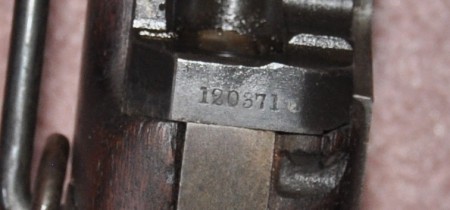
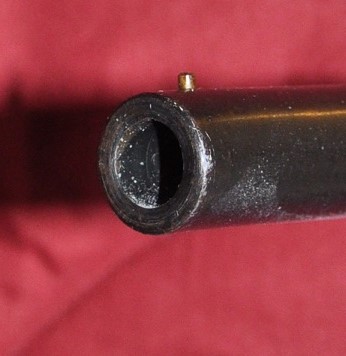
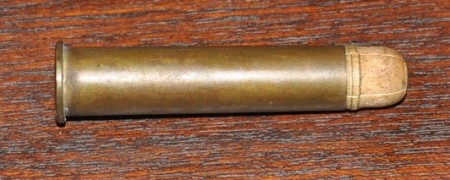
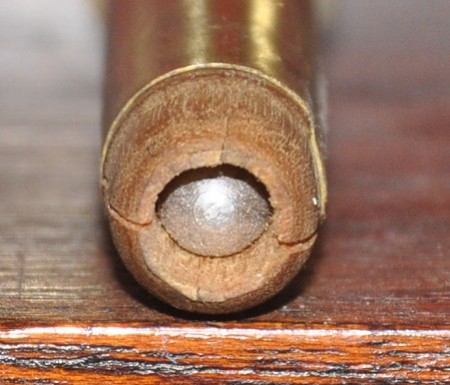
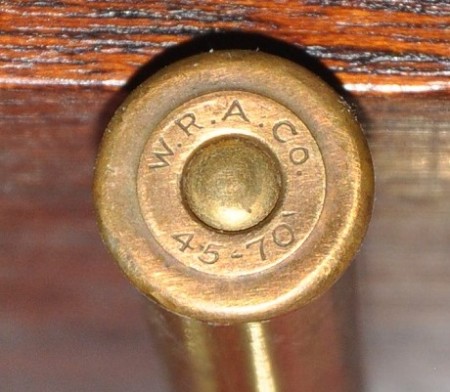
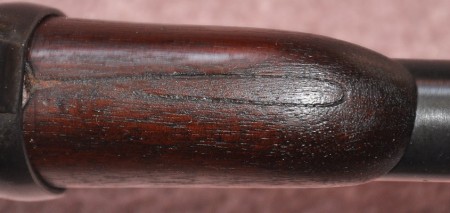
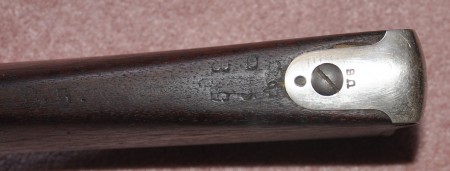
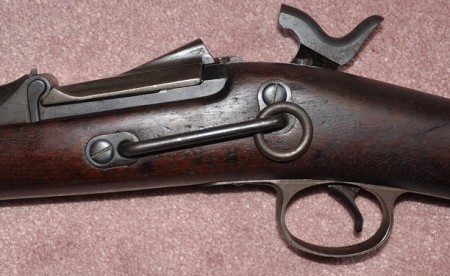
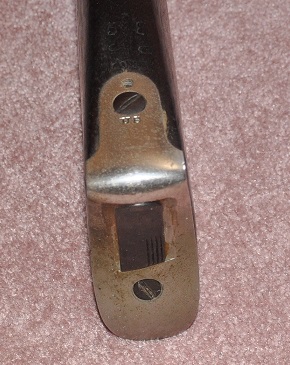
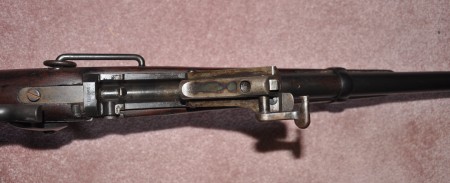
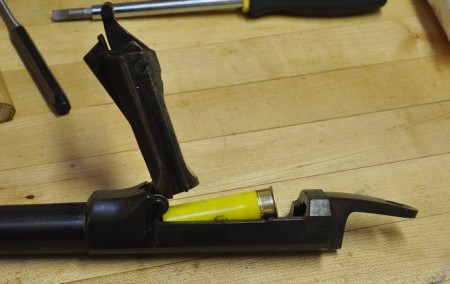
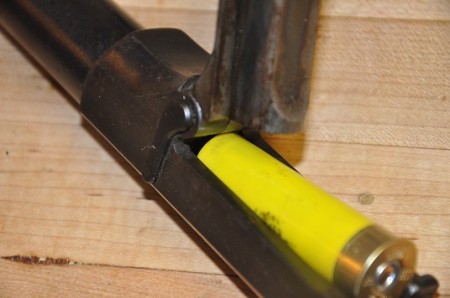
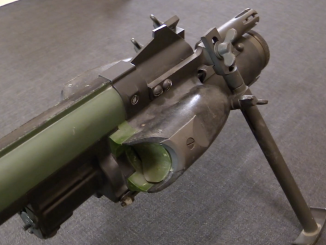
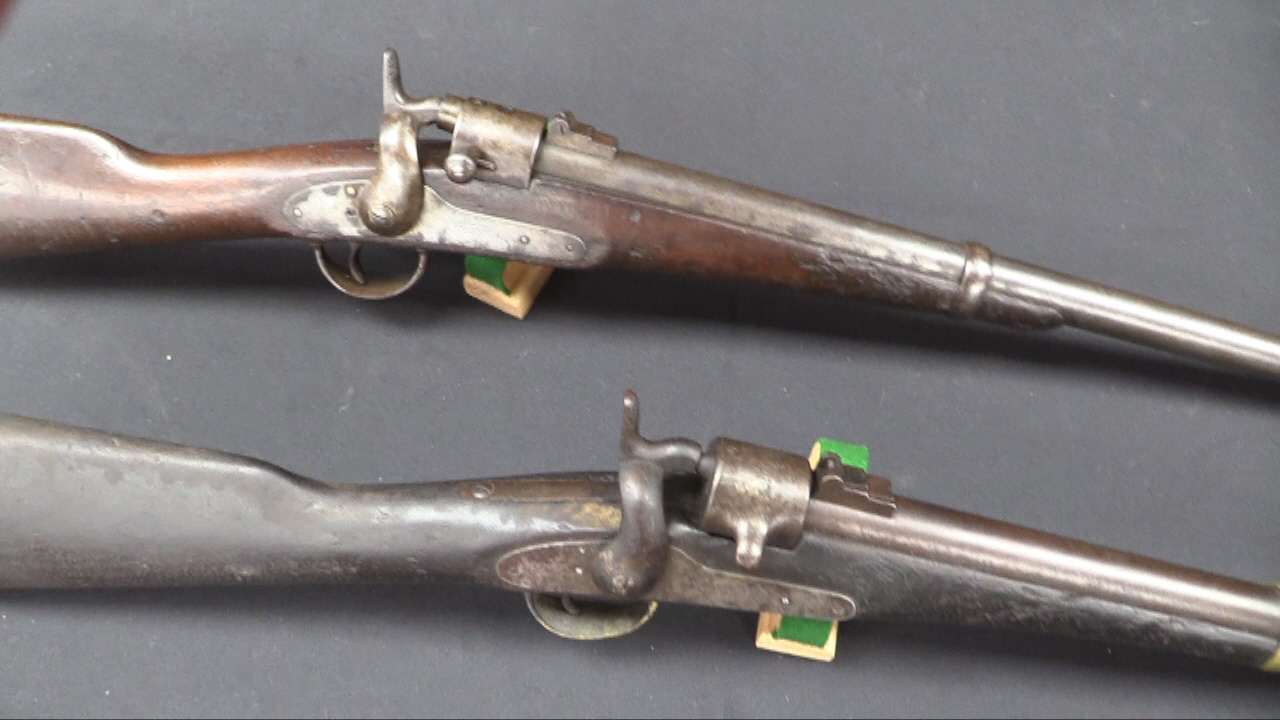
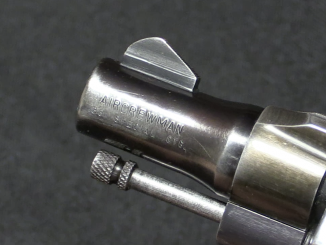
A beautiful gun and great photos and description. I fired an original Trapdoor Springfield as a kid and the solid thump to my shoulder, the impressive smoke and the thwack of the bullet hitting the trees about 100 yards away were all very memorable.
It seems that someone picked up this rifle at a surplus sale and cut down the stock and barrel. The rear sight was removed as it would be unnecessary. The problem: no trace of any rifling in the barrel at all, as indicated…
This thing has “Frances Bannerman” written all over it.
Dave.. have considered that; however, have seen and at one time owned a couple Bannerman rebuilds .. To my knowledge Banner never fine finished any weapon they sold .. just made’m shootable (kinda) and sold’em. Doing this kind of wood work alone would have cost them more than they could have sold them for. That’s my dilemma .. not knowing for sure. Also a friend has a exact type barrel, in very old brown greased paper! Bought at an estate sale.
All .. This weapon SHOOTS like a JEWEL! I am loading #6 shot over HC110 (much cleaner and with a.410 loading low pressure; under 15,000 psi). Holds a pretty nice pattern at 25 yds.
Thomas, thanks very much for sharing. A beautiful firearm with a storied history, and just as importantly, an owner who fully understands and treasures its historical value on a website that does the same!
Hi Earl .. What do you think, what is your considered opinion? I thought for sure someone on this net would have at least seen one like this. Especially since it is a demonstrable fact that Winchester make shot cartridges, and not just the wood projectile type, but #6 & #7 1/2 shot in 45-70 brass 2 1/2 inch ctg. I’m sure (well acutely almost sure!) someday someone or I will say “”There it is.” //
Hi, Thomas :
For what it’s worth ( I’m not as knowledgeable as you or several of the guys here are on this particular subject ), I’m guessing you may have one of a “limited edition” or customized small batch of Springfield Trap Doors. Not exactly a “forager” gun, but something based on the original weapon with some very nice added features that combine the best of both worlds.
Perhaps something made specially for senior officers of a particular arm such as the cavalry? The mystery deepens :).
It could be an experimental model, as the later Forager shows the idea for a shotgun trapdoor was there. Started as a full length model, was found to be unwieldy, and converted to carbine length and fittings. Not introduced as the cartridge was probably not ideal for the purpose, too underpowered. Now how to prove that …
I must sugest : a weapon for awild West shoow.
Bll Cody had two Single action army made up in smooth bore, for shooting ballonesfrom horse back
“Also a friend has a exact type barrel, in very old brown greased paper!”
That is the point that has me stymied. The existence of another barrel like yours suggests something other than a one-off gunsmith special.
Also, a bore diameter at the muzzle of .56 is larger than needed to shoot .45-70 shotshells. The diameter may suggest that the barrel at some point met with a 28 gauge barrel reamer. That would explain the clean appearance of the smooth bore. Any sign of rifling would have been effaced by going from .45+ to .56-
If the above sounds to you like sheer guesswork on my part, I congratulate you on your perceptiveness.
Kendal .. Thanks,as I too have done a great deal of speculating.. “it seem to be this, or but maybe that, but of course it could be on the other hand a …” True enough about the 28ga. I keep hoping someone out there will have an identical or near identical weapon and a historical document that addresses them. A friend in Louisiana looked at it last week while visiting me and after much looking, turning and feeling said, “Well ..any way .. sure make a neat LAMP.” With some of my friends; I have come to believe the only taste they have is in their MOUTH!
Cut down rifle stock with a carbine sling ring installed after the stock was built. Carbines did not have the cleaning rod channel. I do not believe it is experimental. It is like several I have seen and rejected. Sorry. This is a Bannerman type shotgun. They are nice old guns, but it wasn’t used like this in its current configuration.
Doby .. you have seen this exact type “carbine” from Bannerman??? And if rejected .. why?
I actually owned two Bannerman at one time and they were NOTHING in “workmanship” like this. I tend to suspect this was done by a competent gunsmith, while most of Bannerman’s workers were NOT gunsmiths .. they were “assemblers.” But is a possibility all the same.
All Thanks.. I just located something that may shed some light on this;
Bannerman Catalogue of Military Goods, 1927 (Paperback) by Francis Bannerman Sons (Author), Joseph Schroeder (Introduction)
It is on Amazon .. I should have known!!!!
Could it have been for officer recreation? Would account for the fine workmanship. Basing it on the issue rifle could justify itself as training, when Captain so-and-so wanted to go shoot some ducks.
Jacob .. Yes officers had a pretty “wide authority range” at that time .. so who knows except for the other barrel I have seen. Another interesting aspect is that all parts are original/correct to that period, and it does not seem to have had a lot of field use, but has been carried and used and taken care of. Thanks for the thoughts Jacob.//
Oy, am I the only former enlisted man hanging out around here? The minute I heard “forager’s guns” I flashed to the officer mess and the enlisted chow line where the scum were eating beans and hardtack and the officers were having some quail, venison and duck. I just have this image of the “forager” mess cooks with smoothbore Springfields knocking down a few birds so the wardroom won’t have to eat the same beans and bacon the enlisted swill do.
hahahaha No Jim your not the only enlisted puke making commo checks into FW. 24 yrs active Army then 22 yrs as “Excepted Service” (a category) of civil service with the Army SOF. In between those 2 yrs as a “contract field” person with a OGA. I have had at times had the same feeling. All my time was in Combat Arms. As for the large variance in the conduct of EM and Zeros; that was probably the biggest reason I went SF in 61. But ya know what Jim .. I never did learn to jump over tall buildings at a single bound; I did the language qualification pretty good, but never did get shit about the bullet proof down pat! hahahahaha Enlisted men are not always the most eloquent; but we have always had a bad habit about speaking the unvarnished truth. Which some zero’s consider ..rude and uncouth! LoL
One more NCO here. You are right — there was a time when the privileged officer class really did live well above the EM’s, and when class distinctions were much stronger than they are now. There is still a narrow but less visible line that exists to this day in many quarters, although nothing quite like what it used to be.
Thomas’ comments about the “zero’s” and other assorted inequities ring so true.
Good morning Earl! I was wondering where you disappeared to. No offense meant to anyone. But time and again “what was; and is, good for the goose was considered too good for the gander” Every month there is a EM getting court martialed for something a General or colonel was “admonished” for; at the most. You were an EM??
Anyway .. Thanks for your estimate of what this carbine is. Hope someone out there maybe finds another one and some documentation. EVEN an advertisement!
Ah, the joys of being enlisted….
http://www.youtube.com/watch?v=wt1kK8gsag4
Nicholson’s finest moment, in a Dixie Cup hat. The Darryl Ponsican novel “The Last Detail” that the movie is based on is an outstanding look at the enlisted/ officer relationship. (And Portsmouth Naval Prison, speaking of places you do not EVER want to go.)
At the time it didn’t seem like that big of a deal, but over the years I’ve had a lot of fun running into Marine and Airborne vets who look at the submarine dolphins pinned to my hat and say “Dude, you must have been out of your damned mind!” When the Marines think you are crazy you have received an expert opinion…..
A US version of the Greener shotgunÉ http://world.guns.ru/shotgun/brit/greener-police-gun-e.html
Thank you Drone .. incredible piece of history. There have been several “official arsenal” conversion type rifles to shot gun by many countries and like the various countries .22 caliber military trainers; they don’t get much attention. I sure would like to find one of the greener’s.//
A little off-topic, but this post and the earlier post about trap-door foragers reminded me of a Remington Rolling-Block that’s been in the family forever; a rifled carbine converted into use as a shotgun. At some point, the rear sight was removed and the mounting holes plugged, and a bead affixed to the end of the barrel. The rifling is intact and in good shape except for an extensive patch near the end of the barrel.
I wonder if it simply became common in the late 19th & early 20th century to treat rifles chambered for large but obsolescent or unavailable rounds, but with otherwise sturdily built receivers, as shotguns, where appropriate. Neither that rolling-block action or barrel would be likely to burst under the pressure of early smokeless shotgun shells. Why get rid of it if you can convert it into a rugged squirrel and varmint whacker?
My father only remembered it being used as a shotgun (28 gauge, I think); he didn’t even know it was rifled until I found it in my grandmother’s closet and cleaned it up!
Judging from the various stamps it appears to have been made for either a foreign government or export. I don’t know exactly when how how it came into the family, but apparently my grandfather used it when he was a kid in the 1920s.
Thanks TKT .. Yes since I started collecting information on “converted to shotgun” weapons it is amazing to me that no one I can find has written anything about them. I just early America, ranchers, farmers, cattle driving cowboys all hunted, and a shot filled cartridge was not uncommon. Even flint lock and percussion weapons were used with shot. In recent history the SMLE has seen service in .410. I hope you hang onto that Rolling-Block, it has history infused into it.//
Well, everyone, I’ve spent the afternoon with the 1927 Bannerman catalog, Guns of the Wild West by “George Markham” (whoever wrote that one under the pseudonym- the “Markham” Guns of the Reich was written by John Walter), the 1972 Petersen Guns of the World (with a photo article on Springfield Armory prototypes, etc.), and even a reprint of the 1909 Sears & Roebuck catalog.
Nothing.
I’m tending to suspect, though, that this may have been the work of Sears or another mail-order company, to make a slow-moving surplus item more salable. It probably would have gone for $5 or less, but the point would be moving it out of the warehouse.
This would also explain the care and attention paid to fit and finish. After all, they’d want repeat business just like anybody else, and unlike Bannerman they wouldn’t often be able to get away with saying “sold ‘as is'”.
Just a guess.
cheers
eon
I wonder if these were produced for bank/prison guards or security staff? In the UK there was a history of producing smoothbored muskets and shot loads for use by guards where there was an intention to limit the lethality.. Either to prevent the guard causing too much collateral damage in an urban environment, or not to equip staff with too powerful a weapon that could be misused or seized by the opposition!
The Greener security shotgun is a good example of this class of weapon. This type of arms is still widely used in India.
The existence of an identical barrel still in the paper suggests that someone was doing this barrel alteration routinely. Artisan unknown. It would tell us a lot if we knew who and when.
Why is easy enough. It is an intelligent use of available materials and technology. Bore and hone army surplus barrels using the readily available 28 gauge tooling, but leave the .45-70 chamber as is. Shoot it using the readily available .45-70 brass. I’ve fired shotshells in bores larger than they were meant for, using chamber converters, and they worked rather well. I would think it would work just fine to use a .45-70 shotshell behind a 28 bore. (.46 versus .56.) Probably a very nice shooter.
Kendal .. thanks for your comment about the BBL, that is on my list of what I know for that exact reason. Your right; it does shoot very nice. And you are also right about the WHO and WHEN questions.//
Does cleaning rod has enlarged head like on ramrod?
I have seen some odd conversions of Werndl 1867 single shot carbine that used barrels converted for smoothbore (of about 14mm – 28g) caliber, but it used original cartridge in blank version, not crimped but plugged with waxed cardboard disk…
Shot was loaded via muzzle and came packaged in paper wraps with cardboard top and bottom. No markings was present on ammo.
Cleaning rod came with enlarged head and was used as ramrod for shot package.
Oddest thing I have ever seen, it was owned by family friend who inherited it from his grandfather who was a gamekeeper in early 20th century.
France saw large numbers of chaussepots and german rifles converted to 12 20 16 and 24 gauge after the franco prussian war. In 1894 the price of a converted chaussepot was about 50 francs a break action shotgun between 60 and 122 francs. I don’t know if the original barrel was bored out or not. Ten years ago I picked up a chaussepot barreled action in 16 gauge for 10 euroes and missed out on a superb dreyse in 16 for a 100 euroes
i also have a 45/70 springfield carbine converted to 28ga their used to be a trace of rifling until i ran a hone thru barrel.shoot skeet and trap with it.my email does not work.use jameschapman2009@windstream.net .also have snider conversion 12ga ,zula
A little late to the conversation, but I have a smoothbore trapdoor that is almost identical. The barrel and stock on mine have been modified the same way, old rear sight hole plugged, same brass bead front sight, same method of filling in the cleaning rod hole etc.
Mine is serial # 294959
Wow, this is a great post. I inherited one just like this and have been stumped. Serial is 43256, which would place it as made in 1875. Same stock, same cleaning rod hole filler, same front sight. No saddle ring bar, but could have been there previously. The butt plate is a little different. Looks to be same overall length. Would love to share info and ferret out what this rifle is. I have seen a picture , perhaps on the Springfield archive web page, where this type of rifle was used by the Navy to shoot the tender rope over to the other ship, when supplies were to be transferred between ships at sea.
I have an 1873 Springfield which is a 28 ga. shotgun. My father bought it in 1935 for eight dollars. According to an old gun collector, it was converted to a shotgun to kill small game to feed the troops.
Would love to hear from anyone with this model.
The information you share is broad knowledge and people should read it to be more eye-catching. I am very grateful for that. paper io 2